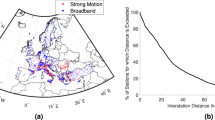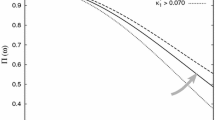Abstract
The technology which is being developed based on the seismic entropy method for monitoring and forecasting the earthquakes in the territory of Russia is described. This technology relies on seismostatistics and makes it possible to automate the monitoring system and to efficiently tap the networks of ground-based and ground-and-satellite-based observations of operative precursors. The main seismic systems responsible for the preparation of the strong earthquakes with magnitudes М ≥ 5.5 are described. The track and energy diagrams constructed for each seismic system provide the means for monitoring the preparation and forecasting the strong earthquakes in the real-time mode. Forty-four seismic systems controlling almost all seismically hazardous regions in Russia were identified and tested in real time during the period from 2010 to 2015. The guidelines for the practical application of the results of monitoring and forecasting are developed.
Similar content being viewed by others
References
Akopian, S.Ts. and Dzhaginyan, G.M., Focal mechanisms of the strong earthquakes and dynamics of plate-block structure of Tauro-Caucasian region, Izv. Akad. Nauk Arm., Nauki Zemle, 1992, no. 2, pp. 48–55.
Akopian, S.Ts., Description of seismic processes on the Armenian Upland based on seismic entropy, XXVI General Assembly of the European Seismological Commission, Papers, Tel Aviv, Israel, August 23–28, 1998, pp. 150–154.
Akopian, S.Ts., Quantitative description of seismic processes based on seismic entropy, Izv. Akad. Nauk, Fiz. Zemli, 1998, no. 1, pp. 11–26.
Akopian, S.Ts., Dissipative seismic systems, entropy, and possibilities of constructing the seismic weather prediction system, in Al’manakh “Delovaya Slava Rossii,” III vypusk (Almanac “Business Glory of Russia”, vol. 3), 2007, pp. 42–46.
Akopian, S.Ts. and Popov, E.A., Technology for forecasting strong earthquakes based on the method of seismic entropy, Materialy konferentsii “Geologicheskie opasnosti” (Proc. Conf. “Geological Hazards”), September 17–19, 2009, Arkhangel’sk, 2009.
Akopian, S.Ts., Quantitative Description of Seismic Processes in Real Medium and the Algorithm of Longterm Prediction of Large Earthquakes: by Examples of the Armenian Upland, North-Western Iran, Italy, and Central California, Moscow: Triumph Publishing, 2013.
Akopian, S.Ts., Monitoring and forecast of the Van earthquake (October 23, 2011) in the seismic system Tavro-Caucasus, Book of Abstracts, 2nd European Congress on Earthquake Engineering and Seismology, Istanbul, August 25–29, 2014a, pp. 25–29.
Akopian, S.Ts., Seismic systems of Japan: entropy and monitoring of the Tohoku earthquake, March 11, 2011, Seism. Instrum., 2014b, vol. 50, no. 4, pp. 347–370.
Akopian, S.Ts. and Kocharian, A.N., Critical behaviour of seismic systems and dynamics in ensemble of strong earthquakes, Geophys. J. Int., 2014, vol. 196, pp. 580–599. doi 10.1093/gji/ggt398
Akopian, S.Ts. and Rogozhin, E.A., Modeling kinematics of the Tauro-Caucasus region and dynamics of strong (M = 7.1) earthquakes preparation, Seism. Instrum., 2014, vol. 50, no. 2, pp. 125–139.
Akopian, S.Ts., Open dissipative seismic systems and ensembles of strong earthquakes: energy balance and entropy funnels, Geophys. J. Int., 2015, vol. 201, pp. 1618–1641.
Akopian, S.Ts., Seismic systems, entropy production law, and ensembles of strong earthquakes, Izv., Phys. Solid Earth, 2016, vol. 52, no. 6, pp. 845–866
Aslanyan, A.T., Zakaryan, K.A., Akopian, S.Ts., Karakhanyan, A.S., and Mikaelyan, A.O., On the deep structure of Tauro-Caucasian region based on the results of seismological studies and remote sensing, Izv. Akad. Nauk Arm. SSR, Nauki Zemle, 1982, no. 4, pp. 3–11.
Bakun, W.H. and Hopper, M.G., Magnitudes and locations of the 1811-1812 New Madrid, Missouri, and the 1886 Charleston, South Carolina, earthquakes, Bull. Seismol. Soc. Am., 2004, vol. 94, pp. 64–75.
Bondur, V.G. and Smirnov, V.M., Method for monitoring seismically hazardous territories by ionospheric variations recorded by satellite navigation systems, Dokl. Earth Sci., 2005, vol. 403, no. 5, pp. 736–740.
Bondur, V.G. and Zverev, A.T., A method of earthquake forecast based on the lineament analysis of satellite images, Dokl. Earth Sci., 2005a, vol. 402, no. 4, pp. 561–567.
Bondur, V.G. and Zverev, A.T., A method of earthquake forecast based on the lineament dynamic analysis using satellite imagery, Issled. Zemli Kosmosa, 2005b, no. 3, pp. 37–52.
Bondur, V.G., Garagash, I.A., Gokhberg, M.B., Lapshin, V.M., Nechaev, Yu.V., Steblov, G.M., and Shalimov, S.L., Geomechanical models and ionospheric variations related to strongest earthquakes and weak influence of atmospheric pressure gradients, Dokl. Earth Sci., 2007, vol. 414, no. 1, pp. 666–669.
Bondur, V.G., Krapivin, V.F., and Savinykh, V.P., Monitoring i prognozirovanie prirodnykh katastrof (Monitoring and Forecasting the Natural Catastrophes), Moscow: Nauchnyi mir, 2009.
Bondur, V.G., Garagash, I.A., Gokhberg, M.B., Lapshin, V.M., and Nechaev, Yu.V., Connection between variations of the stress-strain state of the Earth’s crust and seismic activity: the example of Southern California, Dokl. Earth Sci., 2010, vol. 430, no. 1, pp. 147–150.
Bondur, V.G., Garagash, I.A, Gokhberg, M.B., and Rodkin, M.V., The evolution of the stress state in Southern California based on the geomechanical model and current seismicity, Izv., Phys. Solid Earth, 2016a, vol. 52, no. 1, pp. 117–128.
Bondur, V.G., Garagash, I.A., and Gokhberg, M.B., Large scale interaction of seismically active tectonic provinces: the example of Southern California, Dokl. Earth Sci., 2016b, vol. 466, no. 2, pp. 183–186.
Chebrov, V.N., Monitoring of seismic activity and earthquakes prediction in Kamchatka, Solnechno-zemnye svyazi I fizika predvestnikov zemletryasenii. Trudy IVMezhdunarodnoi konferentsii, 14–17 avgusta 2007 g. (Solar-Terrestrial Relations and Precursors of Earthquakes. Proc. IV Int. Conf. August 14–17, 2007), Paratunka, Kamchatskii krai, 2007, pp. 470–475. http://www.ikir.ru/ru/Events/Conferences/2007-IV-international/downloads/section_5/section_5_ report_0012.pdf.
Chebrov, V.N., Saltykov, V.A., and Serafimova, Yu.K., Prognozirovanie zemletryasenii na Kamchatke (Forecasting the Earthquakes in Kamchatka), Nikolaev, A.V., Ed., Moscow: Svetoch Plyus, 2011.
Copley, A. and Jackson, J., Active tectonics of the Turkish- Iranian plateau, Tectonics, 2006, vol. 25, TC6006. doi 10.1029/2005TC001906
Dnestryanskii, I.N. and Lobanovskii, Yu.I., Krymsk flood: causes and mechanisms of flooding the town. http://artofwar.ru/i/iwan_d/text_0470.shtml.
Jackson, J. and McKenzie, D., Active tectonic of the Alpine-Himalayan belt between Western Turkey and Pakistan, Geophys. J. R. Astron. Soc., 1984, vol. 77, pp. 188–234.
Kasahara, K., Earthquake Mechanics, Cambridge: Cambridge Univ. Press, 1981.
Milyukov, V.K., Mironov, A.P., Rogozhin, E.A., and Steblov, G.M., Velocities of contemporary movements of the Northern Caucasus estimated from GPS observations, Geotectonics, 2015, vol. 49, pp. 210–218.
Novyi katalog sil’nykh zemletryasenii na territorii SSSR (New Catalog of the Strong Earthquakes in the USSR), Moscow: Nauka, 1977.
Poplavskaya, L.N., Ivashchenko, A.I., Oskorbin, L.S., et al., Regional’nyi katalog zemletryasenii ostrova Sakhalin, 1905–2005 gg. (The Regional Earthquake Catalog of Sakhalin Island, 1905–2005), Yuzhno-Sakhalinsk: IMGiG DVO RAN, 2006.
Radziminovich, N.A., Mel’nikova, V.I., San’kov, V.A., and Levi, K.G., Seismicity and seismotectonic deformations of the crust in the Southern Baikal basin, Izv., Phys. Solid Earth, 2006, vol. 42, no. 11, pp. 904–920.
Rogozhin, E.A., Geodynamics and seismotectonics of the Northern Caucasus, in Geodinamika, seismotektonika i vulkanizm Severnogo Kavkaza (Geodynamics, Seismotectonics, and Volcanism of Northern Caucasus), Moscow, 2001, pp. 17–61.
Rogozhin, E.A., Recent geodynamics and potential earthquake sources in the Caucasian region, in Sovremennye matematicheskie i geologicheskie modeli prirodnoi sredy (Modern Mathematical and Geological Models of Natural Media), Moscow: OIFZ RAN, 2002, pp. 244–254.
Rogozhin, E.A. and Ovsyuchenko, A.N., Seismic and geologic activity of tectonically faulted structures in the Northern Caucasus, Izv., Phys. Solid Earth, 2005, vol. 41, no. 6, pp. 449–461.
Rogozhin, E.A. and Ovsyuchenko, A.N., Seismotectonics of Northwestern Caucasus, Seismicheskaya opasnost' i upravlenie seismicheskim riskom na Kavkaze. Tr. III Kavkazskoi mezhdunarodnoi shkoly-seminara molodykh uchenykh (Seismic Hazard and Seismic Risk Management in the Caucasus. Proc. III Caucasian Int. Workshop for Young Scientists), Vladikavkaz, 2009, pp. 53–71.
Rogozhin, E.A., Ioganson, L.I., Zavyalov, A.D., Zakharov, V.S., Lutikov, A.I., Slavina, L.B., Reisner, G.I., Ovsyuchenko, A.N., Yunga, S.L., and Novikov, S.S., Potentsial’nye seismicheskie ochagi i seismologicheskie predvestniki zemletryasenii—osnova real’nogo seismicheskogo prognoza (Potential Seismic Sources and Seismological Precursors of the Earthquakes as the Basis of Real Seismic Forecasting), Moscow: Svetoch Plyus, 2011.
Slavina, L.B., Myachkin, V.V., and Levina, V.I., The experience of using kinematic precursors of seismic field for forecasting the earthquakes in the Caucasus, in Kompleksnye seismologicheskie i geofizicheskie issledovaniya Kamchatki (Integrated Seismological and Geophysical Studies in Kamchatka), Petropavlovsk-Kamchatskii: Kamchatskii pechatnyi dvor, 2004, pp. 216–227.
Sobolev, G.A. and Ponomarev, A.V., Fizika zemletryasenii i predvestniki (Physics of the Earthquakes and Precursors), Moscow: Nauka, 2003.
Solonenko, A.B., Solonenko, N.V., Mel’nikova, V.I., and Yunga, S.L., The fields of stresses and seismotectonic strains in the Baikal Rift Zone, in Seismichnost’ i seismicheskoe raionirovanie Severnoi Evrazii (Seismicity and Seismic Zoning of Northern Eurasia), 1996, vols. 2–3, pp. 363–371.
Tsuboi, C., Earthquake energy, earthquake volume, aftershock area, and strength of the Earth’s crust, J. Phys. Earth., 1956, vol. 4, no. 2, pp. 63–66.
Zavyalov, A.D., Srednesrochnyi prognoz zemletryasenii: osnovy, metodika, realizatsiya (Medium-Term Forecasting the Earthquakes: Basic Theory, Methods, and Implementation), Moscow: Nauka, 2006.
Author information
Authors and Affiliations
Corresponding author
Additional information
Original Russian Text © S.Ts. Akopian, V.G. Bondur, E.A. Rogozhin, 2017, published in Fizika Zemli, 2017, No. 1, pp. 34–53.
Rights and permissions
About this article
Cite this article
Akopian, S.T., Bondur, V.G. & Rogozhin, E.A. Technology for monitoring and forecasting strong earthquakes in Russia with the use of the seismic entropy method. Izv., Phys. Solid Earth 53, 32–51 (2017). https://doi.org/10.1134/S1069351317010025
Received:
Published:
Issue Date:
DOI: https://doi.org/10.1134/S1069351317010025




